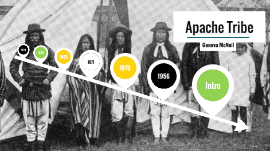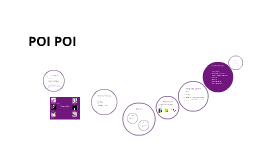Apache PowerPoint
Transcript: Apache Tribe Geneva McNeil 1600 Migration of the Apache Indians The Apaches were typically nomadic which meant they traveled around, never really settling in one place. By 1700 a large portion of the Apache Indians had migrated to the Kansas Plaines. It has been said that the Apache were one of the first tribes to learn how to ride and use horses. They were not accustomed to living and farming on the plains but made due with crops but were eventually overtaken by the Comanche tribe. 1835 Apache vs. Mexican The government of Sonora put a bounty on the Apache which overtime evolved into a payment by the government of 100 pesos for each scalp of a male 14+ years of age. The bounty for one Apache male was more than many Mexican and American workers earned in a full year. This would later lead to what is known as the Apache-Mexican Wars. 1869 Grants "Peace Policy" This policy which was conducted by Ulysses S. Grant, was to replace all the Indian agents with christian missionairies. The policy wanted to continue the strategy of placing Plains Indians into reservations to try and encourage them to become members of White American Society. 1871 Camp Grant Massacre Camp Grant Massacre was an attack on Pinal and Aravaipa Apaches who surrendered to the United States Army at Camp Grant, Arizone, along the San Pedro River. 8 men and 110 women and children were brutally murders, but it is uncertain how many Apaches died that day, it is estimated to about 20-150. 28 Aravaipa Apache Papoose were kidnapped from the scene for sale in the child slave trade and the rest of the corpses left to rot. 1879 Carlisle Indian Industrial School This boarding school was the most famous boarding school ran by Colonel. Pratt at Ft. Marian. This school was seen to further/continue "civilization process". They were given christian, vocational training. Men were taught to farm and girls were taught to cook and clean. They were all stripped of any cultural posession. The federal government pressured families to send kids to boarding school and families will elect to send their kids to boarding school to get fed. The children would have to pick white names and were not allowed speak their native language or else they would get beat. For the younger Indian kids enrolling in these boarding schools, they did not have time to learn their Indian culture which made it easier to "civilize" them. For the older kids, it was harder for them to let go of their Indian culture. 1956 Relocation Act This program was a United States law intended to encourage American Indians to leave Indian reservations and their traditional lands, and to assimilate into the general population in urban areas. The act did not force people to leave their reservations but it made it hard for families to stay by dissolving federal recognition of most tribes, and ending federal funding forreservations schools, hospitals, and basic services. And although the federal government paid for relocation expenses to the cities, urban Native Americans faced high levels of job discrimination, and few opportunities for job advancement. Urban Indians In Tommy Oranges novel "There, There", he introduces many characters that represent the experience of urban Indian life. One of the characters I read was Tony Loneman who were one of many urban Indians who may have felt out of place with their culture and may have even felt that they were not "real Indians" and felt plastic being as they grew up in Urban cities rather than a more traditional setting such as the reservations. This could have been how it was in reality for a lot of Indian children that grew up in urban cities when moved as a child during the Relocation Act. Conclusion Conclusion Throughout this PowerPoint, I gave a timeline of events that I thought was significant to the resilience of the Apache as a whole. The Apache went through many wars with Mexicans, other Indians and 50 years of war with white settlers that still even go on to this day. The Apache Wars were fought by several tribes of the Apache nation including the Chiricahua, Jicarilla, Mescalero, Chihenne or Warm Springs Apaches and Lipan Apaches together with the Western Apache and the Plains Apache tribes. I also went into detal about the hirstorical contextualization that was behind the selected dates. Citation History Timeline of the Apache Wars. (n.d.). Retrieved from https://www.preceden.com/timelines/285060-history-timeline-of-the-apache-wars

















